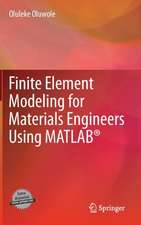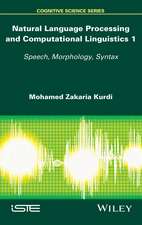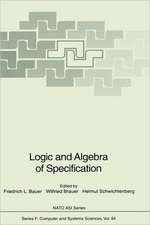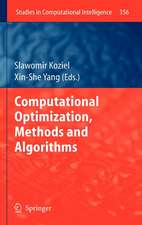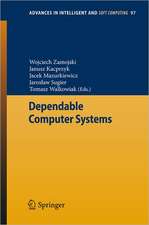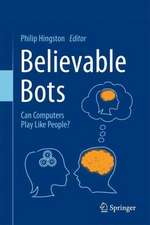Spatial Cognition II: Integrating Abstract Theories, Empirical Studies, Formal Methods, and Practical Applications: Lecture Notes in Computer Science, cartea 1849
Editat de Christian Freksa, Wilfried Brauer, Christopher Habel, Karl F. Wenderen Limba Engleză Paperback – 24 mai 2000
Din seria Lecture Notes in Computer Science
- 20%
 Preț: 1061.55 lei
Preț: 1061.55 lei - 20%
 Preț: 307.71 lei
Preț: 307.71 lei - 20%
 Preț: 438.69 lei
Preț: 438.69 lei - 20%
 Preț: 579.30 lei
Preț: 579.30 lei -
 Preț: 410.88 lei
Preț: 410.88 lei - 17%
 Preț: 427.22 lei
Preț: 427.22 lei - 20%
 Preț: 596.46 lei
Preț: 596.46 lei - 15%
 Preț: 448.04 lei
Preț: 448.04 lei - 20%
 Preț: 353.50 lei
Preț: 353.50 lei -
 Preț: 389.49 lei
Preț: 389.49 lei - 20%
 Preț: 309.90 lei
Preț: 309.90 lei - 20%
 Preț: 645.28 lei
Preț: 645.28 lei - 20%
 Preț: 763.23 lei
Preț: 763.23 lei - 15%
 Preț: 580.46 lei
Preț: 580.46 lei - 20%
 Preț: 310.28 lei
Preț: 310.28 lei - 20%
 Preț: 655.02 lei
Preț: 655.02 lei - 20%
 Preț: 1183.14 lei
Preț: 1183.14 lei - 20%
 Preț: 340.32 lei
Preț: 340.32 lei -
 Preț: 449.57 lei
Preț: 449.57 lei - 20%
 Preț: 591.51 lei
Preț: 591.51 lei - 18%
 Preț: 938.83 lei
Preț: 938.83 lei - 20%
 Preț: 337.00 lei
Preț: 337.00 lei - 20%
 Preț: 649.50 lei
Preț: 649.50 lei - 20%
 Preț: 607.40 lei
Preț: 607.40 lei - 20%
 Preț: 1414.79 lei
Preț: 1414.79 lei - 20%
 Preț: 1024.44 lei
Preț: 1024.44 lei - 20%
 Preț: 583.40 lei
Preț: 583.40 lei - 20%
 Preț: 453.32 lei
Preț: 453.32 lei - 20%
 Preț: 575.49 lei
Preț: 575.49 lei - 20%
 Preț: 1075.26 lei
Preț: 1075.26 lei - 20%
 Preț: 585.88 lei
Preț: 585.88 lei - 20%
 Preț: 825.93 lei
Preț: 825.93 lei - 17%
 Preț: 360.20 lei
Preț: 360.20 lei - 20%
 Preț: 763.23 lei
Preț: 763.23 lei - 20%
 Preț: 340.32 lei
Preț: 340.32 lei - 20%
 Preț: 504.58 lei
Preț: 504.58 lei - 20%
 Preț: 369.13 lei
Preț: 369.13 lei - 20%
 Preț: 580.93 lei
Preț: 580.93 lei - 20%
 Preț: 343.62 lei
Preț: 343.62 lei - 20%
 Preț: 350.21 lei
Preț: 350.21 lei - 20%
 Preț: 583.40 lei
Preț: 583.40 lei - 20%
 Preț: 583.40 lei
Preț: 583.40 lei - 15%
 Preț: 438.59 lei
Preț: 438.59 lei - 20%
 Preț: 341.95 lei
Preț: 341.95 lei - 20%
 Preț: 238.01 lei
Preț: 238.01 lei - 20%
 Preț: 538.30 lei
Preț: 538.30 lei
Preț: 339.34 lei
Preț vechi: 424.17 lei
-20% Nou
Puncte Express: 509
Preț estimativ în valută:
64.93€ • 67.80$ • 53.62£
64.93€ • 67.80$ • 53.62£
Carte tipărită la comandă
Livrare economică 15-29 aprilie
Preluare comenzi: 021 569.72.76
Specificații
ISBN-13: 9783540675846
ISBN-10: 3540675841
Pagini: 424
Ilustrații: XII, 424 p.
Dimensiuni: 155 x 233 x 26 mm
Greutate: 0.61 kg
Ediția:2000
Editura: Springer Berlin, Heidelberg
Colecția Springer
Seriile Lecture Notes in Computer Science, Lecture Notes in Artificial Intelligence
Locul publicării:Berlin, Heidelberg, Germany
ISBN-10: 3540675841
Pagini: 424
Ilustrații: XII, 424 p.
Dimensiuni: 155 x 233 x 26 mm
Greutate: 0.61 kg
Ediția:2000
Editura: Springer Berlin, Heidelberg
Colecția Springer
Seriile Lecture Notes in Computer Science, Lecture Notes in Artificial Intelligence
Locul publicării:Berlin, Heidelberg, Germany
Public țintă
ResearchCuprins
Maps and Diagrams.- Cognitive Zoom: From Object to Path and Back Again.- Monitoring Change: Characteristics of Dynamic Geo-spatial Phenomena for Visual Exploration.- The Use of Maps, Images and “Gestures” for Navigation.- Schematizing Maps: Simplification of Geographic Shape by Discrete Curve Evolution.- Schematic Maps as Wayfinding Aids.- Some Ways that Maps and Diagrams Communicate.- Spatial Communication with Maps: Defining the Correctness of Maps Using a Multi-Agent Simulation.- Schematic Maps for Robot Navigation.- Motion and Spatial Reference.- From Motion Observation to Qualitative Motion Representation.- Lexical Specifications of Paths.- Visual Processing and Representation of Spatio-temporal Patterns.- Orienting and Reorienting in Egocentric Mental Models.- Investigating Spatial Reference Systems through Distortions in Visual Memory.- Spatial Relations and Spatial Inference.- Towards Cognitive Adequacy of Topological Spatial Relations.- Interactive Layout Generation with a Diagrammatic Constraint Language.- Inference and Visualization of Spatial Relations.- A Topological Calculus for Cartographic Entities.- The Influence of Linear Shapes on Solving Interval-Based Configuration Problems.- Navigation in Real and Virtual Spaces.- Transfer of Spatial Knowledge from Virtual to Real Environments.- Coarse Qualitative Descriptions in Robot Navigation.- Oblique Angled Intersections and Barriers: Navigating through a Virtual Maze.- Modelling Navigational Knowledge by Route Graphs.- Using Realistic Virtual Environments in the Study of Spatial Encoding.- Navigating Overlapping Virtual Worlds: Arriving in One Place and Finding that You’re Somewhere Else.- Spatial Memory.- Influences of Context on Memory for Routes.- Preparing a Cup of Tea and Writing a Letter: DoScript-Based Actions Influence the Representation of a Real Environment?.- Action Related Determinants of Spatial Coding in Perception and Memory.- Investigation of Age and Sex Effects in Spatial Cognitions as Assessed in a Locomotor Maze and in a 2-D Computer Maze.
Caracteristici
Includes supplementary material: sn.pub/extras


